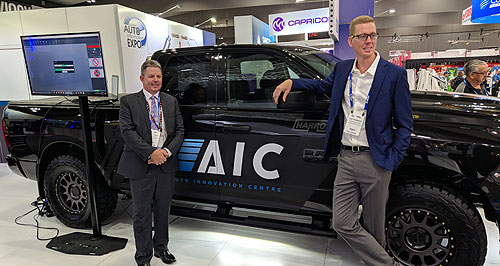News - General News - PartsAAAA to set up new vehicle research centresBeam me up, Scottie: Through advanced vehicle scanning tools, the Auto Innovation Centres can accurately map, measure and log complex shapes such as the bodywork of a vehicle to use in parts development simulations. Aussie car parts to hit the market sooner with help from new Auto Innovation Centres5 Apr 2019 By TUNG NGUYEN THE Australian Automotive Aftermarket Association (AAAA) is preparing to open two vehicle analysis centres in Victoria and South Australia to accelerate the development and reduce the costs of local aftersales product and component design and manufacturing.
Announced at the Australian Auto Aftermarket Expo in Melbourne this week, the Automotive Innovation Centres (AIC) are co-funded by federal and state governments, with the Victorian facility to open by the end of the year and South Australian operations to begin in 2020.
Equipped with advanced data capture equipment that can scan and recreate whole vehicles in a digital three-dimensional space, the centres will provide crucial information to expediate the parts-making process without compromising quality.
Advanced 3D printing hardware will also be on hand at the centres, as well as facilities for staff training on use of equipment and tools.
Initially, the AIC will focus on gathering data on vehicles which are often heavily modified, with the data-scanning demonstration vehicle at the show being a full-sized Ram 2500 pick-up truck, but expect to see the top-selling, accessory-heavy Toyota HiLux, Ford Ranger and Mitsubishi Triton recorded in the near future.
According to AIC manager Luke Truskinger, AAAA members will determine which vehicles the laboratory first gathers data on, but that a high skew towards pick-ups and off-road wagons is anticipated.
“Picking the right vehicle is key, we’re not going to do every single vehicle in our carparc … vehicles that are going to be modified are going to be our key target vehicles, and that’s going to be quite a big library of cars,” he said.
“Over two thirds of our industry are focused on accessorising four-wheel-drive and SUV and camping. Performance is noticeably less than that.
“But it’s a democracy, if our members say they want different vehicles, we’ll get different vehicles.”
As for how long it takes to collect and collate the necessary data, Mr Truskinger said the AIC could retain a vehicle for up to 12 months as it prioritises certain aftermarket accessories over others.
“It (data gathering) depends on the vehicle. There’ll be some vehicles that we just want to do scans on, particularly just a variant of a particular vehicle,” he said.
“We would keep a vehicle from anywhere from three to 12 months, and so the initial data has to come very quickly because time to market is essential for our industry – we try and get that done in the first four to six weeks.
“But it really depends on who is fighting for time-to-market the most, so there’s a lot of companies that focus on service parts, which means you’ve got a bit of time.
“Then you’ve got companies that want to accessorise the vehicles, and when customers buy a new car, they want that product on the car now.”
Importantly, the AIC vehicle data can be passed on to aftermarket companies which can study, model and mock-up parts and designs much quicker than would normally be possible – a crucial point, according to Mr Truskinger.
“It is key for our industry to be fast reacting,” he said. “These people who have made this truck (Ram 2500), they’ve been making it for five years, when they release it … Our process starts when the truck hits the market, so speed is imperative.
“These are the things and the tools and the equipment that we are going to provide access to for our members, as well as access to the cars themselves, they are welcome to come to the centre and utilise the vehicles for testing.
“Our primary function is to assist the Australian automotive aftermarket companies to compete in Australia and internationally.”
The Melbourne centre, which will be located near Monash University south-east of the city, will only employee four people, but the centre will also have space for engineering and development teams from parts-makers to set up shop and use its equipment.
The South Australian centre location is yet to be locked in, but AAAA chief executive Stuart Charity said the vision is “for it to be a national centre of excellence for dynamic testing” with a focus on brake, stability control, towing and advanced driver assist testing.
Mr Charity would not confirm whether the South Australian AIC will be situated in Tailem Bend to make use of the recently opened Bend Motorsport Park that features a skidpan and 7.77km circuit, but said talks had taken place.
“We’ll be providing test facilities and state-of-the-art equipment to help take product development to the next level,” Mr Charity said.
“We also want to reduce the cost and time of that product development process, because that is vital for international competitiveness.”  Read more29th of March 2019  Aftermarket sector in demandExpo shows strength in auto aftermarket, despite car-maker exit, soft new-car sales15th of October 2018  Parts industry recovering from shutdown: AAAAAAAA boss says there is a lot to be positive about with local parts industry |
Click to shareGeneral News articlesResearch General News Motor industry news |
















Facebook Twitter Instagram